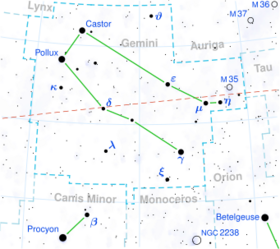Astronomy:Sigma Geminorum
| Observation data Equinox J2000.0]] (ICRS) | |
|---|---|
| Constellation | Gemini |
| Right ascension | 07h 43m 18.72698s[1] |
| Declination | +28° 53′ 00.6422″[1] |
| Apparent magnitude (V) | 4.20[2] |
| Characteristics | |
| Spectral type | K1 III[3] + dG/K[4] |
| U−B color index | +0.97[2] |
| B−V color index | +1.11[2] |
| Variable type | RS CVn[5] |
| Astrometry | |
| Radial velocity (Rv) | +25.56±2.72[6] km/s |
| Proper motion (μ) | RA: +62.66[1] mas/yr Dec.: −230.32[1] mas/yr |
| Parallax (π) | 26.08 ± 0.19[1] mas |
| Distance | 125.1 ± 0.9 ly (38.3 ± 0.3 pc) |
| Absolute magnitude (MV) | +1.36[7] |
| Orbit[8] | |
| Period (P) | 19.6027±0.0005 d |
| Semi-major axis (a) | 4.63±0.04 mas |
| Eccentricity (e) | 0 |
| Inclination (i) | 107.7±0.8° |
| Argument of periastron (ω) (secondary) | 0° |
| Details | |
| σ Gem A | |
| Mass | 1.28±0.07[8] M☉ |
| Radius | 10.1±0.4[8] R☉ |
| Luminosity | 39±2[8] L☉ |
| Surface gravity (log g) | 2.54±0.02[8] cgs |
| Temperature | 4571±5[6] K |
| Metallicity [Fe/H] | 0.0[8] dex |
| Rotation | 19.47[9] |
| Rotational velocity (v sin i) | 26.2[6] km/s |
| Age | 5±1[8] Gyr |
| σ Gem B | |
| Mass | 0.73±0.03[8] M☉ |
| Other designations | |
| Database references | |
| SIMBAD | data |
Sigma Geminorum (σ Gem) is a binary star[9] system in the constellation Gemini, just to the northeast of Pollux. It is visible to the naked eye with an apparent visual magnitude of 4.20.[2] Its annual parallax shift of 26.08 mas[1] indicates that it is located 125 light years from the Sun.

Sigma Geminorum is a single-lined spectroscopic binary,[9] which means that the spectrum of only one of its components can be discerned. It is an RS Canum Venaticorum variable with a period of 19.6 days,[9] matching the orbital period. The stellar luminosity shows indications of ellipsoidal variation, as the primary component is partly filling its Roche lobe due to gravitational interaction between the two stars.[8]
The primary component is an evolved K-type giant star with a stellar classification of K1 III.[3] It has a relatively high rate of spin for a giant star, showing a projected rotational velocity of 26.2 km/s[6] and a rotation period of 19.47 days.[9] This rate is being maintained by the tidal interaction between the two stars. The surface of the primary has large star spots that are locked onto the face oriented toward the secondary component.[9] These spots appear to migrate poleward at an average velocity of 0.12±0.03 km/s.[9] The surface activity makes the star a bright X-ray emission source[11] with a luminosity of 119.41×1029 ergs s−1.[4] It displays indications of anti-solar differential rotation.[9]
The primary has 1.28 times the mass of the Sun, but has expanded to 10.1 times the Sun's radius.[8] It shines with 39[8] times the solar luminosity from its outer atmosphere at an effective temperature of 4571 K.[6] It is roughly 5[8] billion years old.
References
- ↑ 1.0 1.1 1.2 1.3 1.4 1.5 van Leeuwen, F. (2007), "Validation of the new Hipparcos reduction", Astronomy and Astrophysics 474 (2): 653–664, doi:10.1051/0004-6361:20078357, Bibcode: 2007A&A...474..653V.
- ↑ 2.0 2.1 2.2 2.3 Mermilliod, J.-C. (1986), "Compilation of Eggen's UBV data, transformed to UBV (unpublished)", Catalogue of Eggen's UBV Data (SIMBAD), Bibcode: 1986EgUBV........0M.
- ↑ 3.0 3.1 Eggen, O. J. (1962), "Space-velocity vectors for 3483 stars with proper motion and radial velocity", Royal Observatory Bulletin 51: 79, Bibcode: 1962RGOB...51...79E.
- ↑ 4.0 4.1 Makarov, Valeri V. (October 2003), "The 100 Brightest X-Ray Stars within 50 Parsecs of the Sun", The Astronomical Journal 126 (4): 1996–2008, doi:10.1086/378164, Bibcode: 2003AJ....126.1996M.
- ↑ Samus, N. N. et al. (2009). "VizieR Online Data Catalog: General Catalogue of Variable Stars (Samus+ 2007-2013)". VizieR On-line Data Catalog: B/GCVS. Originally Published in: 2009yCat....102025S 1. Bibcode: 2009yCat....102025S.
- ↑ 6.0 6.1 6.2 6.3 6.4 Massarotti, Alessandro et al. (January 2008), "Rotational and radial velocities for a sample of 761 HIPPARCOS giants and the role of binarity", The Astronomical Journal 135 (1): 209–231, doi:10.1088/0004-6256/135/1/209, Bibcode: 2008AJ....135..209M.
- ↑ Cardini, D. (January 2005), "Mg II chromospheric radiative loss rates in cool active and quiet stars", Astronomy and Astrophysics 430: 303–311, doi:10.1051/0004-6361:20041440, Bibcode: 2005A&A...430..303C.
- ↑ 8.00 8.01 8.02 8.03 8.04 8.05 8.06 8.07 8.08 8.09 8.10 8.11 Roettenbacher, Rachael M. et al. (July 2015), "Detecting the Companions and Ellipsoidal Variations of RS CVn Primaries. I. σ Geminorum", The Astrophysical Journal 807 (1): 10, doi:10.1088/0004-637X/807/1/23, 23, Bibcode: 2015ApJ...807...23R.
- ↑ 9.0 9.1 9.2 9.3 9.4 9.5 9.6 9.7 9.8 Kővári, Zs. et al. (January 2015), "Antisolar differential rotation of the K1-giant σ Geminorum revisited", Astronomy & Astrophysics 573: 9, doi:10.1051/0004-6361/201424138, A98, Bibcode: 2015A&A...573A..98K.
- ↑ "sig Gem". SIMBAD. Centre de données astronomiques de Strasbourg. http://simbad.u-strasbg.fr/simbad/sim-basic?Ident=sig+Gem.
- ↑ Huenemoerder, David P. et al. (May 2013), "Stellar Coronae, Solar Flares: A Detailed Comparison of σ GEM, HR 1099, and the Sun in High-resolution X-Rays", The Astrophysical Journal 768 (2): 15, doi:10.1088/0004-637X/768/2/135, 135, Bibcode: 2013ApJ...768..135H.
External links
- Kaler, James B. (September 9, 2015), "Sigma Geminorum", Stars (University of Illinois), http://stars.astro.illinois.edu/sow/sigmagem.html, retrieved 2016-12-08.
 |


